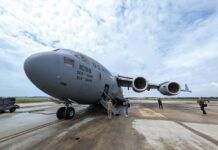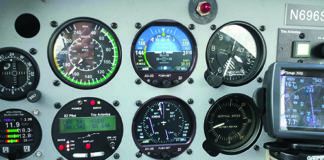On September 5, 2014 the chairman of the TBM Owners and Pilots Association, Larry Glazer and his wife, Jane were on board a Socata TBM 900 single-engine turboprop that crashed into the ocean off the coast of Jamaica. According to the NTSB preliminary report, about an hour and a half into the flight from Rochester, New York to Naples, Florida, the pilot became unresponsive after reporting an “indication that is not correct in the plane.” The fighter jet pilots who escorted the aircraft to the Cuban airspace border suspected possible hypoxia.
On August 30, 2014 Ronald Hutchinson, a retired executive from Harley-Davidson, was on board a Cirrus SR22T which crashed into the ocean off the Virginia coast. According to the preliminary NTSB report, the aircraft took off from Waukesha, Wisconsin at 10:43 CDT and climbed to 21,000 feet. The aircraft maintained this attitude for an hour before descending first to 17,000 feet, then to 15,000 feet and finally to 13,100 feet.
The aircraft remained at approximately 13,100 feet until apparently running out of fuel. When the aircraft passed the flight’s intended destination at Manassas, Virginia and entered restricted airspace around Washington, D.C., two North American Aerospace Defense Command aircraft were dispatched to intercept the flight. The intercept aircraft pilots confirmed that the pilot of the Cirrus was unconscious and attempts to revive him were unsuccessful. The intercept aircraft followed the Cirrus until it impacted the Atlantic Ocean.
Both these accidents are still under investigation by the NTSB, so no official cause has been published. However, in both cases there’s a lot of circumstantial evidence that supports the conclusion that the pilots became hypoxic during the course of their flight. These accidents are eerily similar to the 1999 Learjet crash in which the professional golfer Payne Stewart and five others lost their lives. The NTSB accident report for the Learjet crash states the probable cause as, “Incapacitation of the flight crewmembers as a result of their failure to receive supplemental oxygen following a loss of cabin pressurization, for undetermined reasons.”
How Can this Happen?
Both Glazer and Hutchinson were highly-experienced pilots with several thousand hours of flight time in their log books. It’s safe to assume that both pilots were quite familiar with the aircraft they were piloting. Could that familiarity be what started the chain of events leading to their demise?
Humans with the flying gene in their DNA, are problem solvers first and foremost. When something is not right, our first impulse is to analyze the problem, find the cause and fix it. While this is an excellent approach for most in-flight problems, it can be fatally wrong when the brain is being starved of oxygen. This is because one of the earliest symptoms of hypoxia is a false sense of well-being (euphoria).
As your brain is being gradually starved of oxygen, you think that the situation is getting better, while in reality you are nearing total collapse. High altitude chamber experiments reliably show that experienced pilots are more likely to report no effects of hypoxia when they are obviously affected. This insidious nature of hypoxia is what makes it so dangerous.
Although we may never know with certainty, in the case of the recent accidents, the pilots’ familiarity with their respective aircraft may have added to their misplaced confidence that they could diagnose and solve the in-flight problem. All the while, as they were attempting to problem-solve, their mental functions were decreasing rapidly. Once the pilots lost consciousness, their fates were sealed.
How to Recognize Hypoxia?
Immediately after the TBM accident, AOPA Safety Institute sent out a safety alert. The alert listed some of the typical symptoms of hypoxia, which are: cyanosis (blue fingernails and lips), headache, hot flashes, visual impairment or reduced visual acuity, tunnel vision, drowsiness, lightheaded or dizzy sensation, decreased reaction time, impaired judgment, tingling in fingers and toes, numbness and of course euphoria.
Knowing the typical symptoms of hypoxia is no guarantee that a pilot will be able to recognize its onset. With the resulting loss of cognitive abilities upon the onset of hypoxia, recognizing its symptoms becomes difficult. Also, every individual’s physiological response to hypoxia is unique.
The best solution is to carry a relatively inexpensive and powerful tool in your flight bag. This tool is the fingertip pulse oximeter, which retails for as little as $30. The fingertip pulse oximeter clips onto the tip of a finger and has a readout of the blood oxygen saturation level. As long as the oximeter shows levels of 90 percent or more, your brain is getting sufficient oxygen. At blood oxygen saturation levels below 90 percent, cognitive abilities start to deteriorate and you should either descend to lower altitudes or use supplemental oxygen.
The AOPA safety alert states it in no uncertain terms. “If you fly regularly above 10,000 feet, a pulse oximeter should be part of your equipment and you should check your oxygen saturation levels regularly during the fight.”
Deal With It
So, you got a pulse oximeter for Christmas. How often should you use your pulse oximeter?
If you’re flying an unpressurized aircraft above 10,000 feet, you should check your oxygen saturation once every 30-60 minutes. If you stay at the same altitude, you might argue that oxygen saturation probably hasn’t changed much since the last reading, but environmental conditions can make a difference. If your reading is below 90, even just 89, put on a mask, then figure out what changed. What if you are already wearing a cannula? Put on a mask and descend; because you have problems. (Empty tank? Bad tube?)
If you’re flying a pressurized aircraft, you can experience a slow pressure loss that will likely go undetected. For that reason, the aircraft has a warning that typically comes on with a cabin pressure altitude above 10,000 feet. See the alarm? Put on a mask immediately and quickly.
You can also experience a sudden pressurization loss, such as might occur with a dump valve failure. Your ears will let you know about that. Ears suddenly want to explode? Put on a mask immediately and quickly.
Last is explosive decompression, such as from a window failure. All of your senses will tell you about that. Put on a mask immediately and quickly.
Central to all of these pressurization failures is “Put on a mask immediately and quickly.” Where is your oxygen mask? Possibly in a seat-back pocket behind you? How quickly can you put it on? Under 10 seconds? Probably not, but in the high flight levels you might not have much more time than that before you’re unable to function reliably.
You should have a mask readily available, plugged into the oxygen source. You should be able to put it on and turn on the oxygen within 10-15 seconds. If you regularly fly above 10,000 feet, practice it.
Aircraft that regularly fly above FL240 or so have quick-donning masks that can literally be put on in under five seconds. Your needs might be more modest, but you must be quick about it.
Part 121 pilots are trained to recognize and react to hypoxia. Standard procedures for most airlines instruct crew members to first don their supplemental oxygen masks before they begin to analyze and solve an in-flight pressurization problem. Whether pressurized or not, if you regularly fly above 10,000 feet, step one on your in-flight emergency checklist should read, “Don supplemental oxygen mask.” You can then proceed with the rest of your emergency checklist.




